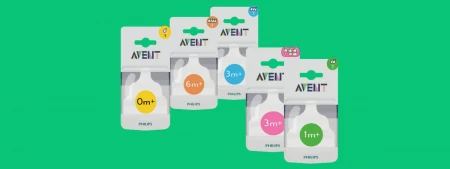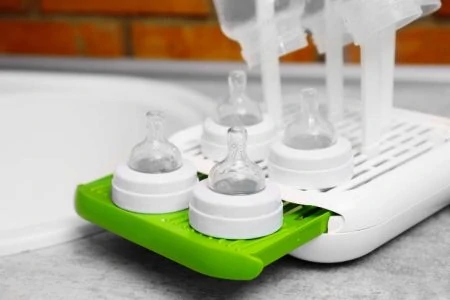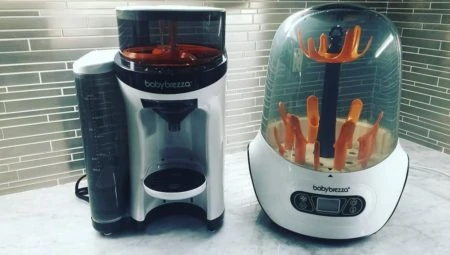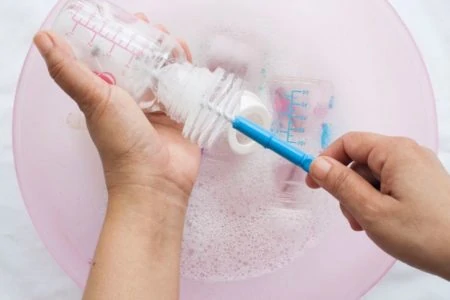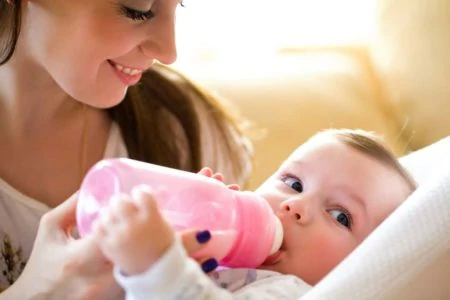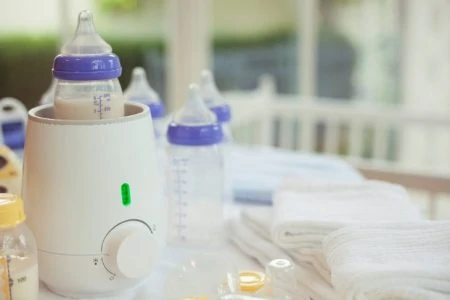Like adults, most babies don’t enjoy change. You may think bottles and sippy cups are similar, but to a baby who has spent countless hours receiving comfort and nourishment from their bottle, the differences can feel astronomical.
Experts recommend you stop using bottles by a baby’s first birthday. But switching from bottles to sippy cups is really challenging for some babies. You want to do all you can to make the transition a smooth one.
We’ve been there, and we’ve learned a few tricks along the way. Check out these nine steps to make the transition from bottles to sippy cups easier for everyone.
Key Takeaways
- Introduce a sippy cup with solid foods and without the spout for easy drinking around the time of introducing solid foods to a baby.
- The earlier you introduce the sippy cup, the easier the transition will be.
- Remove the valve from the sippy cup to make it easier for babies to extract the liquid.
- Start with a silicone spout to make the transition easier.
- Introduce new flavors to the sippy cup to help entice the baby to drink from it.
When To Introduce a Sippy Cup
It’s a good idea to introduce a sippy cup of water (with the spout removed for easy drinking) when you introduce solid foods. At this age, the goal isn’t that your baby will drink anything but instead become familiar with the sippy cup and start to associate it with meal times.
Introducing but not forcing the sippy cup early can make your transition easier. If you wait too long, your child can develop a difficult-to-break attachment to their bottle. For these reasons, pediatricians recommend you drop the bottle completely by your child’s first birthday.
However, don’t worry if you’re parenting an older baby and still haven’t started with a sippy. We’ve got some tips and tricks for you.
Reasons to Transition
Prolonged bottle usage is associated with several negative health outcomes, including (1):
- Tooth decay.
- Obesity.
- Picky eating.
- Poor nutrition.
- Misaligned teeth.
- Overbite.
- Ear infections.
How to Transition from Bottle to Sippy Cup
Sometimes it takes trial and error to get results. To increase your chance of transitioning without tears, try the following:
1. Start Early
Introduce your child to a sippy cup with solid foods. Occasionally during their feeding, tip the cup’s spout to their mouth so they learn what it’s for.
Don’t expect your baby to drink a measurable amount or satisfy their thirst with the sippy cup. In the beginning, it’s more about developing skills and habits early than the actual function of the cup.
The earlier you introduce the sippy cup, the fewer tantrums you’ll have to deal with during the transition.
Consider giving your baby an empty sippy cup to play with. Allowing them to handle the cup may make them more likely to accept it when you use it with liquids. When your family is eating, let your baby have a sippy cup. Then see if you can get them to mimic you as you take a sip from your own cup.
Editor's Note:
Michelle Roth, BA, IBCLC2. Remove The Valve
Whether you’re working with an infant or an older baby, until your child gets the hang of drinking from a sippy, remove the valve. While the valve prevents spills, it makes the liquid harder to extract from the cup, potentially causing frustration.
Allow the water to flow freely — and, yes, messily — until your child understands how the cup works. Then, replace the valve when they’re ready.
3. Start With a Silicone Spout
A flexible silicone spout will feel familiar to a bottle-fed baby, so it may make the initial transition easier. Many bottle manufacturers make sippy spouts compatible with their bottles to aid in the transition. Once your child is used to drinking from a silicone sippy spout, it will be easier to transition to other sippy cup styles.
4. Offer Something Besides Water
Yes, water is best for your baby. But it’s also boring and flavorless, which makes it difficult to entice a seemingly uninterested baby. For their initial introduction to the cup, fill it with diluted juice, and rub a little of the sweet juice on the spout.
Bring the spout to your baby’s lips, allowing them to taste the sweetness. More often than not, they’ll be interested enough to figure out how to get more. Once your child has the hang of the sippy, revert to only offering water with meals.
5. Offer a Sippy Cup Instead of a Bottle
After your child has mastered the sippy cup, start to use it as a replacement for bottles at regular bottle-feeding times.
Fill the cup with formula, and feed it to your baby instead of their bottle. If you are exclusively breastfeeding, offer the sippy cup at mealtimes with solid food. Don’t worry about feeding your baby milk in a cup unless you are specifically trying to wean them from nursing.
6. Go Easy on the Nighttime Bottle
When you’ve effectively replaced all your child’s bottles with sippy cups, you still need to get them on a “big-kid” eating schedule. If your child is accustomed to a pre-bedtime feeding, gradually reduce the volume of their nighttime bottle (now cup). Instead, feed them a protein-rich snack to fill their belly before bed.
You can also start to create some time between the final feeding and bedtime. If you typically feed your child their last bottle in their nursery, feed them in the living room instead. This helps you slowly break their bedtime association with milk while still ensuring they go down with a full belly.
7. Quit Cold Turkey
As an alternative to slowly replacing bottles with sippy cups, you could simply eliminate all bottles at once and make the complete transition to sippy cups overnight. While it may create some initial stress, the transition will be much quicker.
8. Follow Through
“Follow through” will be your number one parenting rule, so you might as well start now and get used to it.
Take Note
9. Quit All Bottles Around Age One
If your baby hasn’t reached the one-year mark, strongly consider getting them off the bottle around the time their birthday arrives. After that, they can develop stronger attachments to items, including bottles, and breaking the habit can be much more difficult both for you and your baby.






